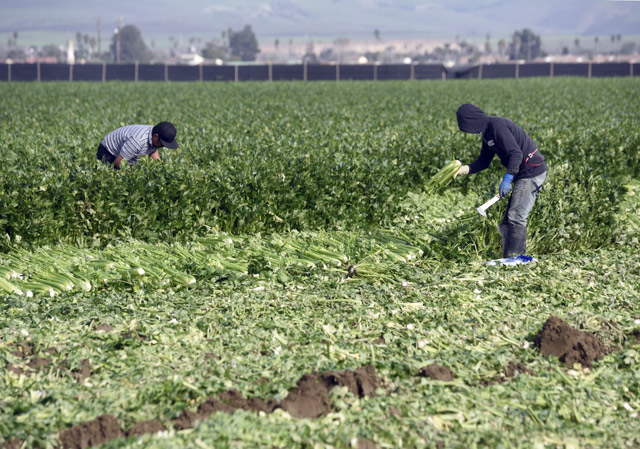Immigrant Fieldworkers: In or Out?
Trump’s Executive Order on Agriculture Could Open Door for Worker Program

Farmers in the Santa Maria Valley are breathing a sigh of relief since President Donald Trump ordered Agriculture Secretary Sonny Perdue two weeks ago to ensure the industry has “access to a reliable workforce.” The faint reference to immigration in his executive order on promoting and regulating agriculture constitutes a sharp departure from Trump’s campaign promise of mass deportations.
It is “the first sign we’ve seen for having an opportunity for some type of guest worker program,” said Santa Barbara Republican Mike Stoker, who has worked on ag policy for more than 20 years. “Otherwise we don’t have a reliable workforce.”
While many farmers share Stoker’s confidence, they disagree about what form such a program would take. A task force of Perdue and White House officials has 120 days to draft recommendations for Trump. Asked if this one line in the executive order amounted to a significant shift, Stoker said Trump has been softening his tune on immigration for two years. “Every president evolves,” he added. “Obama evolved on a lot of issues — thankfully so.”
Stoker, who reportedly is pursuing an appointment to the National Labor Relations Board, famously originated the “lock ’er up” chant at the Republican convention last year.
Roughly 30 percent of the county’s estimated 40,000 undocumented laborers work in agriculture to the north of the Santa Ynez Range, many earning just enough to live there permanently as a strong immigrant community.
The area is also where Santa Barbara’s most conservative voters live; the region’s 4th supervisorial district was the only one in the county where Trump beat Hillary Clinton, by 9 percentage points. Even though many farmers support Trump, they also knowingly hire undocumented farmworkers.
“The Trump administration is in a bind where their proposed mass deportations and border wall would be devastating to their business allies in the ag sector,” said immigrant-rights advocate Lucas Zucker of the Central Coast Alliance United for a Sustainable Economy. “They are looking for a way to have their cake and eat it, too.”
Californians for Population Stabilization spokesperson Joe Guzzardi called Trump’s softened position “extremely disappointing,” adding, “There’s not a shred of evidence that more ag workers are needed.” There is “no shortage of anything” at the farmers markets or grocery stores, he claimed, adding that growers have fabricated the issue in an attempt to get an “abundance of labor.”
Yet white Californians have not been seen working in the fields for years. “It’s backbreaking work, and I’m pretty sure there aren’t a lot of millennials filling out applications at our local farms,” said conservative 5th District Supervisor Steve Lavagnino, who has said he did not vote for Trump.
In fact, most Republicans and Democrats agree the immigration system needs reforming; they just disagree on how to get there. Many Republicans have abandoned their old hard-line mentalities, Stoker said, and would probably support reform as long as citizenship is not included. Citizenship tends to be a sticking point for Democrats, though, particularly coastal Democrats, he added.
Farmer George Adam of Innovative Produce said perhaps undocumented workers could be issued “resident alien cards and [paid] so much to achieve that status.” Otherwise, farmers say they won’t be able to compete with cheap produce from Central and South America increasingly stocked in grocery stores.
Most area farmers support some type of a guest worker program, as a labor shortage of an estimated 25 percent straps the county, leaving $11 million of crops to rot in the field.
The growth of strawberry farms has only made it worse. More hands are required to delicately pick the lucrative crop, and farms are nowhere near automation. They pay an hourly wage of roughly $12.50, which is a few dollars more than growers farming leafy greens and broccoli.
In recent years, Santa Barbara County has brought in the highest number of temporary ag workers as part of the H-2A program in California, according to Zucker. In 2015, the year the most recent data is available, nearly 1,300 immigrants were brought in for up to nine months — about 500 more than the prior year.
Yet almost everyone hates it. Farmers complain the program is cumbersome and expensive, while immigrant advocates say it confines workers to cramped housing and creates an underclass.
“Agriculture policy shouldn’t be driven by people in Washington, D.C., who love strawberries but hate farmworkers,” Zucker said.


